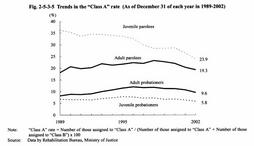| Previous Next Index Image Index Year Selection | |
|
|
3 Various treatment measures (1) Classified treatment system The classified treatment system was introduced in 1971 as a system in which probation officers would actively implement planned and direct measures for parolees and probationers, especially for those who have grave problems with their predispositions and environments in order to make effective use of probation officers' expertise. In this system, parolees and probationers are divided into "Class A" or "Class B" depending on the difficulty of their treatment under certain criteria based on scientific views. For "Class A" parolees and probationers who are judged to have a number of problems and to be difficult to treat, probation officers communicate with them, their family members and other persons concerned to give them direct advice as well as undertake active liaison with authorities concerned. Probation officers shall also undertake liaison and discussion positively and efficiently with volunteer probation officers.
Fig. 2-5-3-5 shows the trends in the rate of parolees and probationers who were assigned to "Class A" since 1989. Since 1999, the "Class A" rate has been slightly decreasing for both adult parolees and adult probationers. Fig. 2-5-3-5 Trends in the "Class A" rate (As of December 31 of each year in 1989-2002) (2) Categorized treatment system Categorized treatment is a system whereby the problems and other characteristics of parolees and probationers are divided into categories according to the nature of the crime or delinquency, environmental conditions and other circumstances. Concrete treatment guidelines are set for each category and effective treatment is implemented focusing on the characteristics of each category. This system was introduced in 1990 for the purpose of improving treatment measures from a different perspective from the classified treatment system. As of December 31, 2002, 27.5% of adult parolees and 18.4% of adult probationers were assigned to the "Stimulant drug offense" category, 3.3% and 4.1% to the "Connection to organized crime groups" category, and 4.3% and 4.6% to the "Sexual offense" category (Source: Data by Rehabilitation Bureau, Ministry of Justice).
It has been 13 years since the enforcement of the categorized treatment system. During this period, legal measures have been taken against new types of crimes, such as child abuse and spousal violence known as DV. A variety of research related to these crimes has also conducted in various areas. In addition to these changes, there have been changes in the actual situation of probationary supervision, such as an increase of elderly parolees and probationers. Taking these changes into consideration the categorized treatment system was reformed to introduce new categories dated March 18, 2003, and came into effect on April 1, 2003. (3) Probationary supervision for long-term sentenced parolees Special measures to enhance and reinforce probationary supervision are taken for long-term sentenced parolees who are to serve a sentence of 8 years or more including life-imprisonment parolees (see Section 2, 3 (2) of this Chapter for parole examinations for long-term sentenced inmates).
Intermediate treatment is a system whereby such long-term sentenced parolees are accommodated in halfway houses for a month from the beginning of parole, if such treatment is deemed to be reasonable for them by the Regional Parole Board and they give their consent. The purpose of this intermediate treatment is to provide parolees with training for daily living and occupational support and to enable them to have a prompt and smooth return to life in the society. In 2002, 114 parolees were subject to intermediate treatment (Source: Data by Rehabilitation Bureau, Ministry of Justice). In July 2000, a new treatment scheme started focusing on the 1 year after the release on parole (or the period of parole if it is shorter than 1 year) as the key treatment period during which direct participation by probation officers is reinforced. Furthermore, new emphasis on treatment was started such as providing guidance and advice from the commencement of probationary supervision with regard to specific means to pay compensation for damage or consolation money to victims and bereaved family members of deceased victims. |
